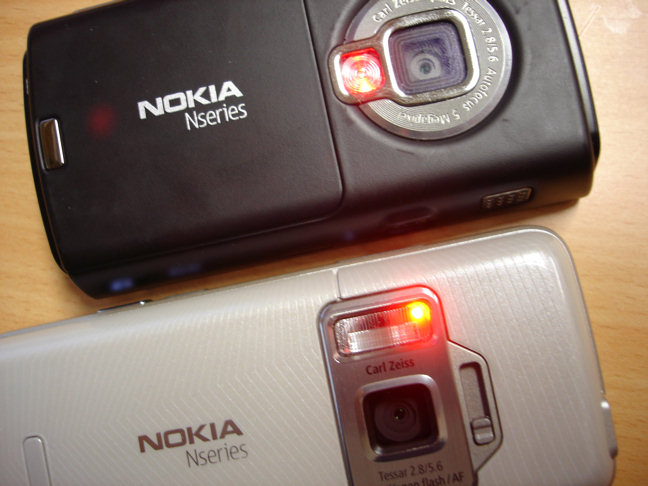The point of a flash when taking a photos is, of course, to add illumination to your subject - which, given the time of day and light levels, is probably a human being (and thus not perfectly static). From 2005 until today, in 2015, taking shots in low light with a phone involved lighting up a (fairly weedy) LED flash and then taking a photo with relatively long shutter duration (e.g. 1/30s), with the result that any movement in either the subject or, indeed your own hand holding the phone, resulted in a degree of motion blur. In other words, results weren't always very crisp.

Smartphone cameras and flashes back in 2008...
Xenon was, of course, one possible solution, first seen in the Nokia N82, using a flash technology with genuinely short duration - around 10 microseconds - providing blindingly good illumination for your perfectly-frozen subject but the background was naturally then pitch dark by comparison, leading to complaints of 'lack of atmosphere'. It seem that phone camera designers can't win...
Another attempt at helping was the introduction of optical image stabilisation (OIS), first seen in the Nokia Lumia 920, adjusting the lens position hundreds of times a second in order to compensate for slight tremors in the user's hands, meaning that the shutter could be left open more reliably, with no motion blur from the user's end but not solving the issue of movement of the subjects while the photo is being taken. ("All together now.... hold still and smile!")
However, all the time, through the last five years:
- camera sensors have become more and more efficient at turning photons of light into digital information, dramatically so.
- camera optics have become larger and more sophisticated, with wider and wider apertures, letting in more light (which rises as the square of the aperture diameter, so a f/1.8 camera unit lets in almost twice as much light as a f/2.4 unit, for the same size sensor).

- camera sensors themselves have been getting larger - we had the Nokia experiments with 1/1.2" and 1/1.5" sensors (808 PureView and Lumia 1020 respectively), though these required just a little too much in the way of corresponding thickness in terms of the optics to feed light in, so most smartphone designs are settling around the 1/2.3" mark these days, after ages stuck at 1/3.2"...
- computer chips (main processors, GPUs, dedicated image processors) have all been getting faster, again dramatically so.
Put all these physical factors together and we're entering a world of phone photography where fewer and fewer shots will need to be taken with flash at all - your mobile device will be able to capture the scene in front of you, exactly as your eyes see it, in a hundredth of a second or so, fast enough that most human subjects will be crisp enough even if they're laughing or talking, and with little visible digital niose. Admittedly you're still not going to freeze jumping dogs or cartwheeling kids in the dark, but for the vast majority of cases the new imaging hardware will be up to the task - without any need to light up a flash.
Yes, this is pushing the laws of physics (coming up on speed of light and quantum effect issues, mainly), but it's far enough for most purposes.
And there's more - software is now starting to play a part too:
- It's going to be pretty easy to shoot 4K video of anything interesting on most top 2015 and all 2016 mid-range smartphones, meaning that on-phone functions will let you swipe from frame to frame, extracting any you wanted as full 8MP stills. For real action scenes, such as someone blowing out birthday candles or jumping a hurdle at a sports event, where you, quite literally, only get one 'shot' at capturing the moment, this 4K video solution is ideal. You have complete peace of mind that whatever happens in front of your eyes has been grabbed and at high resolution, and you can review it and extract as many stills as you want later on. Even as a fan of Xenon for freezing the moment, I'll admit that actually getting the right 'moment' in low light was tricky - with a video solution, you know you'll get the shot - it may not be perfectly crisp, but you'll at least be able to choose the 1/30s time slot in which it was grabbed.

- The same applies to shooting 'burst' mode photos - this will depend on the actual device and its shot to shot time, but this has many of the advantages of the '4K video' solution just mentioned, but with full stills quality and resolution for each photo (i.e. not limited to video frame MP4 compression). Typical burst durations, i.e. per shot are a fifth of a second, though I'd expect this to get down to 1/10s, which should be plenty of time-resolution for most situations, even in low light.
- With masses of processing power available, there's the ability for camera applications to take multiple shots on their own (i.e. silently, without telling you!) and to then intelligently select the best-picture behind the scenes - this is what happens on the newly announced Google Nexus 5X/6P, for example, and, I'm sure, several others. Not that you should be surprised - any phone with a genuine HDR ('Rich Capture' in Lumia parlance) function has been taking multiple shots at capture time for years. But we really are now arriving in an era when you can snap your friends down the pub, huddled around their drinks and looking up at the camera (phone) and software will pick from multiple 'takes' and also use this extra information to remove digital noise and go for 'faces' which don't have eyes closed. And so on, you get the idea, there's a lot of potential here.
So that's at least four physical factors and three software techniques, all taking advantage of the maturing of miniature cameras that can fit inside a smartphone that's not outrageously thick.
And, crucially, put them all to good use and using 'flash' of any kind on a phone camera could well be a thing of the past soon. I was doing head to head tests earlier this year in a dimly lit pub between my Nokia 808 and Lumia 1020 (giant sensor, Xenon flash) and a friend's Galaxy Note 4 (more modern sensor and larger aperture, plus faster processing), with a human subject, and there really wasn't much to choose between the results, much to my surprise.
As a rule, with both biology and physics right at their limits, if your own eyes can perceive subjects (details and colours) crisply enough in a low light/indoor scenario then there's no reason why a 2016 phone camera with advanced enough specification couldn't do likewise. Without having to resort to flash of any kind.
As someone who's made something of a speciality of phone imaging over the last decade, it's great to see the technology maturing and, while the purist in me naturally rejoices more in the physical improvements, I can't deny that the 'software photography' aspects also interest me. After all, what was the Nokia 'PureView' oversampling, if not the dawn of the current age?

Nit-pickers may have picked up a few bits of artistic license above - despite the article featuring the advantages of ultra-modern optics, sensors, and so on, the images depict a mechanical shutter and devices with the same. Ahem. Yes, I know, 2015/2016 camera phones will have an electronic shutter, but you can't help but love the engineering of these Nokia classics, so I'm going to use the images this one last time!
Tomorrow sees the announcement of the two new Lumia flagships running Windows 10 Mobile, the 950/950 XL, and both will have cameras that incorporate all seven of the tech improvements and innovations above. Plus triple LED flash, somewhat oddly given the theme of this feature, but I'm guessing that the idea is that when you do need flash illumination for a photo, i.e. because it really is too dark, then why not put out as much light as possible, again ensuring that the shutter speed can be kept quick and that there's less possibility for blurred subjects.
In terms of imaging, the benchmark to beat is probably the LG G4 still, though Sony's latest Xperia Z5 is up in the same ballpark too. Then there are the new big-pixelled Nexus devices and also the aforementioned camera champions from yesteryear, the Nokia 808 and Lumia 1020. We'll have detailed head to head comparisons for you in due course, so come back in a few weeks!
